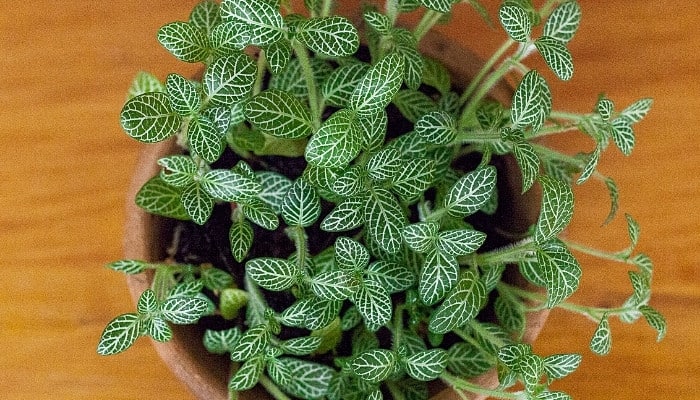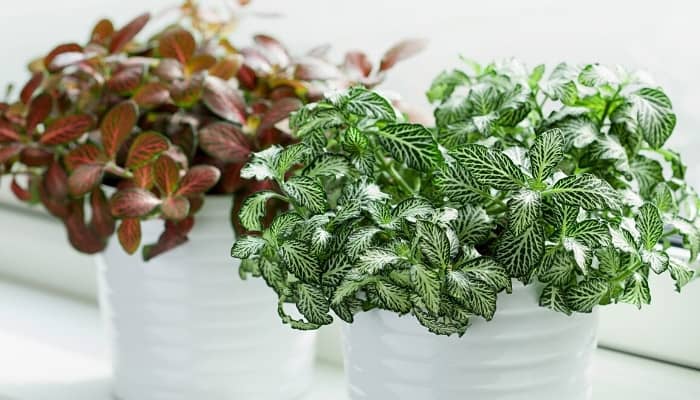It is disheartening to witness your nerve plants wilt, especially after giving them plenty of TLC.
Unfortunately, our plant parental techniques sometimes need a little tweaking to keep our nerve plants healthy and thriving.
Some plants require a certain level of care to keep their foliage healthy and vibrant, and the nerve plant is no exception.
Native to the humid and steamy rainforests of the world, this plant adores warmth, humidity, and dappled light.
Why is my nerve plant drooping? Low humidity levels, poor soil, and an inadequate watering schedule can cause the nerve plant to droop. In addition, sudden temperature drops, insufficient light, and pests can also cause a decline in the tender nerve plant’s foliage.
It’s a common misconception that nerve plants are difficult to grow due to their high maintenance requirements.
In the following, you’ll discover how your nerve plant will continue to thrive without ever having a droopy day by following a few simple practices.
Common Causes of Nerve Plant Drooping
The nerve plant is a tropical plant also known as the Fittonia albivenis. Its delicate foliage is green with contrasting white-silvery veins.
Also known as the mosaic plant or painted net plant, this exotic beauty is the perfect indoor plant that grows easily in containers or hanging baskets.
However, this plant can quickly show signs of distress by drooping; here are some common causes.
Underwatering
Nerve plants are tropical plants and prefer moist soil. Therefore, the soil should not be allowed to fully dry out between soakings as this will quickly cause the plant to droop.
Instead, water the nerve plant every second day as warm indoor temperatures can cause the soil to dry out quickly. Soak the plant with enough water so that it drains freely from the bottom of the container.
Overwatering
Excessive watering can lead to wilting foliage followed by yellowing leaves and root rot. Allow the top layer of soil to dry slightly between each watering session.
Once the excess water has drained into the drip tray, tip the water out to avoid the plant sitting in water and developing root rot.
Lack of Humidity
The rainforest provides the nerve plant with lots of natural humidity. However, central heating and air conditioning can dry the air when the plant is grown indoors, leading to drooping leaves.
Mist the plant regularly or place it near a humidifier to increase humidity levels. Alternatively, you can stand the plant on a pebble tray filled with water.
(Here we show you how to make your own humidity tray with common household items.)
Too Much Light
Overexposure to direct sunlight will cause the leaves to wilt and burn.
Instead, place the plant in an area where it can receive lots of indirect light, such as behind a sheer curtain or on a north-facing window sill.
Low Light
The nerve plant can be found growing on the forest floor beneath the shady fronds of taller plants in its natural habitat.
These low to medium light conditions are optimal for vigorous growth in nerve plants.
Incorrect Temperatures
Nerve plants enjoy the temperate, cozy temperatures of indoors. The optimum temperature range for nerve plants is between 60 and 79℉ (16-26℃). This temperature range encourages even growth.
Cold Drafts
This tropical plant does not enjoy cool temperatures and will quickly show signs of stress. If you live in a cooler climate, keep the plant in temperatures above 60℉ (16℃) to avoid the leaves dropping.
However, avoid placing it near a heater or central heating as this will dry the soil and cause the plant to wilt.
Poor Soil
Poor soil conditions that are either too moist or too dry or completely depleted of nutrients can result in drooping foliage. Instead, provide the plant with moist, organic-rich soil that drains well.
Good soil for nerve plants is loamy soil that is peat based. Feed once monthly in the growing season with a balanced houseplant fertilizer. (This all-natural formula is ideal.)
Pests and Diseases
These tropical, moisture-loving plants are not overly susceptible to pests and diseases. However, root rot is a common disease among overwatered nerve plants.
This fungal disease can cause drooping leaves and plant death. Follow a good watering schedule to prevent root rot.
Also, because the plant adores humidity, it is not totally immune to pests such as mealybugs and spider mites. Spray the plant with insecticidal soap or neem oil (find it here) weekly to prevent infestation.
Recent Repotting
Some plants suffer stress when repotted, and the nerve plant is no exception. Often this is due to the dryer soil conditions drawing moisture away from the roots.
Dampen the soil with water before repotting to prevent the plant from suffering shock when repotted.
How To Revive a Drooping Nerve Plant

Nerve plants are easily revived if action is taken quickly.
Step #1 Ensure the Soil Is Moist and Drains Well
The nerve plant loves moisture. Often the first sign of underwatering is drooping leaves. Saturate the soil thoroughly and ensure the excess water drains away.
The potting soil should drain quickly to prevent soggy soil conditions and root rot.
Provide a good soaking every second day. Use your finger to touch the top of the soil daily to ensure it has not become too dry.
Allow the plant to recover for a day. If no improvement is seen, move on to Step #2.
Step #2 Check That the Plant Is Receiving the Correct Amount of Light
This tropical plant loves indirect light but cannot tolerate direct sunlight very well. Try moving the plant onto an east- or west-facing windowsill to provide it with indirect sunshine.
Alternatively, use a fluorescent light to improve low-lit conditions or a sheer curtain or blind as protection against direct sunlight.
Allow the plant two to three days to recover; however, follow the instructions in Step #3 if no improvement is seen.
Step #3 Increase the Humidity Levels
Humidity is essential to nerve plants as they react badly to dry air quite quickly.
Growing this plant in a terrarium is possibly easier; however, you can follow some basic tips to increase humidity levels in the home.
For example, mist the plant daily using a spray bottle or place the plant on a tray of pebbles filled with water. Don’t allow the water to touch the bottom of the plant container to prevent root rot.
Alternatively, you can use room humidifiers to increase humidity levels. See the one I use with my own plants here.
Lastly, place other plants around the nerve plant to naturally increase humidity.
Step #4 Move Plant Out of Cold Drafts
One other factor to consider when faced with the droopy foliage of a nerve plant is temperature. If the plant is exposed to cold temperatures, its leaves will quickly droop and show signs of stress.
The nerve plant enjoys a cozy temperature range of between 60 and 79℉.
If you think the temperature has dropped below this point, move the plant into a warmer position away from the cold drafts of windows or open doors.
Don’t be tempted to place the plant near the central heating as the soil may dry out and humidity levels will decrease.
Related Questions:
Why Is It Called a Nerve Plant?
Nerve plant is the common name given to the Fittonia albivenis.
The name aptly describes the delicate leaf-vein pattern on the plant’s foliage that resembles a network of nerves or netting, hence another common name – the silver net leaf plant.
Is the Nerve Plant Poisonous?
Although the name may conjure up thoughts of nerve damage and subsequent poisoning, the nerve plant is, in fact, nontoxic to animals and humans.
Conclusion
This flowering, tropical plant is a stunning addition to every plant parent’s home. If provided with enough water, light and humidity, it will thrive and produce vibrant, variegated foliage.
Remember to pinch off the flowers to promote bushier and healthier leaf growth, and if you fall in love with this plant as we have, pop a few stem cuttings into fresh water and propagate a few more nerve plant babies to decorate your home!

